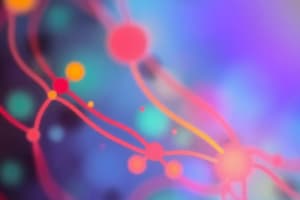Podcast
Questions and Answers
What is a characteristic feature of cantilever array sensors?
What is a characteristic feature of cantilever array sensors?
- They utilize chemical reactions as their primary detection method.
- They can only detect physical changes.
- They require extensive power supply.
- They have a thickness tolerance of 300nm. (correct)
How do nanotube sensors detect molecules?
How do nanotube sensors detect molecules?
- Through chemical reactions with light.
- By detecting changes in temperature.
- Through magnetic resonance techniques.
- By using strands of DNA to bind to target molecules. (correct)
In which application are cantilever array sensors used for diagnosis?
In which application are cantilever array sensors used for diagnosis?
- Detecting acetone in breath for diabetes mellitus. (correct)
- Monitoring cholesterol levels.
- Assessing electrocardiogram signals.
- Testing blood pressure levels.
What is the maximum mass detection capability of NEMS cantilevers for cancer diagnosis?
What is the maximum mass detection capability of NEMS cantilevers for cancer diagnosis?
What distinguishes biosensors from other types of nanosensors?
What distinguishes biosensors from other types of nanosensors?
What is the primary function of a transducer in nanosensors?
What is the primary function of a transducer in nanosensors?
What is the primary power requirement of nanosensors compared to traditional sensors?
What is the primary power requirement of nanosensors compared to traditional sensors?
Which of the following is NOT a type of nanosensor mentioned?
Which of the following is NOT a type of nanosensor mentioned?
Flashcards are hidden until you start studying
Study Notes
What is a Nanosensor?
- A sensor that operates on the scale of atoms and molecules.
- Smaller size, lower weight, and modest power requirements.
- Can be used for data storage systems.
- A transducer converts an input to an electrical signal, which is then detected by a detector.
Nanosensor Technology
- Physical sensors: Measure physical quantities like temperature, pressure, and light.
- Chemical sensors: Detect the presence of specific chemicals, such as pollutants or toxins.
- Biosensors: Interact with biological molecules, such as proteins or DNA, to detect specific substances in biological samples.
Types of Nanosensors
- Cantilever Array Sensors: Utilize micro-electromechanical systems.
- Nanotube Sensors: Composed of carbon nanotubes, which are extremely sensitive to changes in their environment.
- Nanowire Sensors: Consist of thin wires of semiconductor materials, such as silicon or germanium.
Cantilever Array Sensor
- Working: The cantilever array sensor detects biochemical or physical processes by utilizing micro-electromechanical systems.
- Features:
- Precision cantilevers: 300nm thickness tolerance.
- Precision resonance frequency: Achieved by a special cantilever mount.
- Easy handling: Enabled by vertical chip sidewalls and optional non-sticking properties.
- Contamination-free storage.
- Specifications:
- Size/Shape: Rectangular shaped silicon bars (2.5mm wide and 3mm high).
- Duosensis sensors: 2 cantilevers per chip.
- Octosensis sensors: 8 cantilevers per chip.
Applications of Cantilever Array Sensors
- Diabetes Mellitus Diagnosis: Detect small amounts of acetone in breath, aiding in early diagnosis.
- Detection of Bacteria, Fungi, and Viruses: Ultrasensitive detection of antigens on cell membrane surfaces, enabling single bacterium detection (mass of ~1pg).
- Cancer Diagnosis: Detect cancer-associated molecules due to changes in surface tension, bending the cantilever. The mass detection limit is improved to the detection of a single DNA molecule (mass of ~1ag).
Nanotube Sensor
- Size/Shape: Strands of DNA coated nanotubes to detect molecules in the range of parts per million.
- Platform: Can detect molecules in the air or liquid, suitable for applications like domestic security and medical detectors.
Applications of Nanotube Sensors
- Blood Glucose Monitoring: Enzyme glucose oxidase is attached to the sensor. The enzyme catalyzes glucose to produce hydrogen peroxide, enabling blood glucose monitoring.
Studying That Suits You
Use AI to generate personalized quizzes and flashcards to suit your learning preferences.




